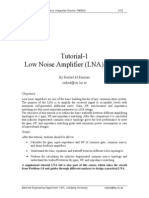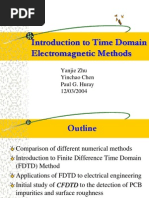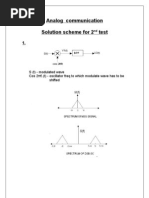Derivation of and of A Mosfet: T MAX
Derivation of and of A Mosfet: T MAX
Uploaded by
Subir MaityCopyright:
Available Formats
Derivation of and of A Mosfet: T MAX
Derivation of and of A Mosfet: T MAX
Uploaded by
Subir MaityOriginal Description:
Original Title
Copyright
Available Formats
Share this document
Did you find this document useful?
Is this content inappropriate?
Copyright:
Available Formats
Derivation of and of A Mosfet: T MAX
Derivation of and of A Mosfet: T MAX
Uploaded by
Subir MaityCopyright:
Available Formats
Derivation of f
T
And f
MAX
of a MOSFET
Derivation of f
T
(MOSFETs)
The unity current gain frequency* (aka
cutoff frequency)
Defined under the condition that the output
is loaded with an AC short.
f
T
does not depend on R
g
and r
o
Derivation of f
T
(MOSFETs) (Continued)
) ( 2
1
) (
) ( ) (
) (
gd gs
m
T
I
gd gs m
gd gs
m
gd gs
gd m
ins
os
I
gd gs gs ins
gs gd gs m gd gs m os
C C
g
f
A when
j
C C g
C C s
g
C C s
sC g
i
i
A
C C sV i
V sC V g i V g i
+
=
=
+
=
+
~
+
=
+ =
= =
t
e
Assume the zero (sCgd) is smaller compared to gm.
e
e
e j j
C C g
A
T
gd gs m
I
=
+
=
) (
f
T
with Parasitic R
S
and R
D
Derivation of f
T
(MOSFETs) (Continued)
(R
S
and R
D
are included)
Millers
Approximation
| |
| |
) (
) ( 1
2
1
) ( 1
) ( // ) (
D S gd
m
gd gs
m
D S m gd gs
T
D S m gd M
D S m o D S m
gs
d
V
R R C
g
C C
g
R R g C C
f
R R g C C
R R g r R R g
V
V
A
+ +
+
=
+ + +
=
+ + =
+ ~ + = =
t
Derivation of f
MAX
(MOSFETs)
f
MAX
* is the frequency at
which the maximum power
gain =1 (*aka maximum
oscillation frequency)
f
MAX
is defined with
its input and output ports
conjugate-matched for
maximum power transfer
So, we need to know the
input and output impedance
to define the input and
output power as well as
achieve the max power
transfer matching condition.
Derivation of f
MAX
(MOSFETs)
gd gs T
gd m
T
o
gd gs
gd m
o
out
gd gs
gd
t
gs
gs m dg
dg gs m
o
t
t
t
t
out
C C C
C g
C
r
C C
C g
r
Z
C C
C
V
V
V g i Assume
i V g
r
V
i
i
V
Z
+
=
+
+
=
+
~ <<
+ + =
//
1
1
&
g
gs
g in
R
C j
R Z ~ + =
e
1
At high frequency (close to
fmax), we can assume that
So, R
g
is independent of R
L
0
1
~
gs
C je
2
os
o out L
i
i R R = =
For the matching conditions,
g
s
ins in g S
R
V
i i R Z
2
= = =
Derivation of f
MAX
(MOSFETs) (Continued)
Conjugate match at the input: Conjugate match at the output:
Power Gain (Under Conjugate Match)
o
g
g gd T
T
MAX
gd T
o
gd gs
gd m
o
L
g
L
T MAX
p
g
L T
g
L
ins
os
in in
out o
p
r
R
R C f
f
f
C f
r
C C
C g
r
R
R
R
f f f
G when
R
R
f
f
R
R
i
i
R i
R i
G
+
=
+
=
+
+
=
= =
=
|
|
.
|
\
|
|
|
.
|
\
|
=
t
t
2
2
1
2
1
1
1
1
2
1
1
4
1
4
1
2 2
2
2
1
2
2
1
Using the
definition of f
T
Derivation of f
MAX
(MOSFETs)(Continued)
(R
S
and R
D
are included)
s g in
R R Z + =
Hence, replace R
g
by R
g
+R
s
o
s g
s g gd T
T
MAX
r
R R
R R C f
f
f
+
+ +
=
) ( 2
2
1
t
For high frequency condition,
C
gs
short
w/o (R
S
+R
D
) term
w/ (R
S
+R
D
) term
Derivation of f
T
And f
MAX
of a BJT
Derivation of f
T
(Bipolar)
For Bipolar Transistors,
BE
DE
DE
dBC
DE dBE
m
T
o be gs
gd gs
dv
dQ
C
C C
C C C
C C
g
f
r V V
C C C C
=
+
+
=
t
t
t
t
) ( 2
C
DE
is due to minority
carriers caused by FB
Derivation of f
T
(Bipolar) (Continued)
BC BE B E DE
Q Q Q Q Q + + + =
Q
E
= minority holes stored in emitter
Q
B
= minority electrons stored in base
Q
BE
= electrons induced by the current
through the depletion region of BE-junction
Q
BC
= electrons induced by the current
through the depletion region of BC-junction
Derivation of f
T
(Bipolar) (Continued)
F
m
dBC dBE
m
dBC DE dBE
m T
m F
BE
C
F
BE
DE
DE
s
BC
s
BE
B
B
E
E
BC BE B E
C
DE
F
g
C C
g
C C C
g
C C
f
g
dv
di
dv
dQ
C
X X
D
W
D
W
t t t t
di
dQ
t
t
t t
v v q q|
t
t
+
+
=
+ +
=
+
=
= =
+ + + = + + + =
2
1
2 2 2 2
2 2
Width of Neutral Region
Width of
Depletion
Region
1 > q
BE
X
if drift current is considered.
is greater than because of reverse-biasing.
BC
X
Derivation of f
T
(Bipolar)
(R
S
and R
D
are included)
For bipolar, the result is similar.
The only difference is that the term must be
included.
| |
| |
) (
) (
) ( 1
2
1
) ( 1
) (
C E dBC F
m
dBC dBE
C E dBC
m
dBC F m dBE
m
C E m dBC DE dBE
T
C E m dBC M
C E m
be
c
V
R R C
g
C C
R R C
g
C g C
g
R R g C C C
f
R R g C C
R R g
V
V
A
+ + +
+
=
+ +
+ +
=
+ + + +
=
+ + =
+ ~ =
t
t
t
F
t
Derivation of f
MAX
(Bipolar)
b bc
T
o
g
b bc T
T
MAX
R C
f
r
R
R C f
f
f
t
t
8
2
2
1
=
+
=
For bipolar transistors, there is no term.
o
r
You might also like
- Buyer SeafoodDocument96 pagesBuyer SeafoodMuhammad Albar Chanas Pratama100% (1)
- SOP For Digital India Internship ProgramDocument2 pagesSOP For Digital India Internship ProgramMD Abdullah100% (1)
- Online Shopping System Software RequirementsDocument3 pagesOnline Shopping System Software RequirementsAnshuman Biswas60% (10)
- Electronic Devices and Circuits Formula SheetDocument6 pagesElectronic Devices and Circuits Formula Sheetmumsn83% (6)
- Categories of Processed Meat ProductsDocument7 pagesCategories of Processed Meat ProductsElena RamonaNo ratings yet
- Derivation of and of A Mosfet: T MAXDocument16 pagesDerivation of and of A Mosfet: T MAXwearole100% (1)
- HFIC Chapter 4 HF TransistorsDocument77 pagesHFIC Chapter 4 HF TransistorsYosra Be100% (1)
- Chap4 Lec1Document23 pagesChap4 Lec1Azeez Abiodun TaiwoNo ratings yet
- Tutorial-1 Low Noise Amplifier (LNA) Design: by Rashad.M.Ramzan Rashad@isy - Liu.se ObjectiveDocument18 pagesTutorial-1 Low Noise Amplifier (LNA) Design: by Rashad.M.Ramzan Rashad@isy - Liu.se ObjectiveRakesh Rt100% (1)
- RF Ch7 Fet Mixer 2008Document61 pagesRF Ch7 Fet Mixer 2008haha2012100% (1)
- 350 NC 7Document36 pages350 NC 7Malou Ruiz DenolanNo ratings yet
- Calculation of Receiver Sensitivity: T V V K T ° Where T V Calibrates Voltage As TemperatureDocument23 pagesCalculation of Receiver Sensitivity: T V V K T ° Where T V Calibrates Voltage As TemperaturevarunmrNo ratings yet
- RFDocument46 pagesRFIshan SinghNo ratings yet
- BwEE2601-13 - BJT and FET Frequency ResponseDocument15 pagesBwEE2601-13 - BJT and FET Frequency ResponseHoa LeNo ratings yet
- ECS 455 Chapter 1: Introduction & ReviewDocument37 pagesECS 455 Chapter 1: Introduction & ReviewKalolo SadathNo ratings yet
- Digital Communications Formula SheetDocument13 pagesDigital Communications Formula SheetSrikanth Reddy Komatireddy100% (1)
- Bandpass SignallingDocument16 pagesBandpass SignallingNitin SahuNo ratings yet
- Analog Modulation System (1) : 4-1, 4-2,4-3, 5-1 Lecture 7, 2008-9-26Document23 pagesAnalog Modulation System (1) : 4-1, 4-2,4-3, 5-1 Lecture 7, 2008-9-26aymanieeeNo ratings yet
- Tutorial-2 LNA PDFDocument19 pagesTutorial-2 LNA PDFTeddy112100% (1)
- Advanced Microwave EngineeringDocument12 pagesAdvanced Microwave Engineeringkwizera evaNo ratings yet
- Analog Modulation: Angle Modulation FM (Frequency Modulation) PM (Phase Modulation)Document25 pagesAnalog Modulation: Angle Modulation FM (Frequency Modulation) PM (Phase Modulation)awais_sohail89No ratings yet
- List of FormulasDocument18 pagesList of FormulasMarlon SobrepeñaNo ratings yet
- ExtraExerciseSolutionsChapter7 PDFDocument25 pagesExtraExerciseSolutionsChapter7 PDFHunain AKNo ratings yet
- hw3 SolDocument6 pageshw3 SolAnthony KwoNo ratings yet
- Tutorial 3 SolutionDocument5 pagesTutorial 3 SolutionMuhanad OfficerNo ratings yet
- FET SSAC-2sp PDFDocument16 pagesFET SSAC-2sp PDFbloodysavageNo ratings yet
- ECE 410 Homework 6 - Solution Spring 2008Document4 pagesECE 410 Homework 6 - Solution Spring 2008murthyNo ratings yet
- Rappaport Sections 4.1-4.6 (Except 4.3)Document21 pagesRappaport Sections 4.1-4.6 (Except 4.3)Mohamed AbdelmawgoudNo ratings yet
- Devices and Circuits Ii: Lecture GoalsDocument5 pagesDevices and Circuits Ii: Lecture GoalsMạnh Cường TrầnNo ratings yet
- Introduction To Time Domain Electromagnetic Methods: Yanjie Zhu Yinchao Chen Paul G. Huray 12/03/2004Document40 pagesIntroduction To Time Domain Electromagnetic Methods: Yanjie Zhu Yinchao Chen Paul G. Huray 12/03/2004Ashish VermaNo ratings yet
- Mosfet Small SignalDocument7 pagesMosfet Small SignalTabraizShahNo ratings yet
- Duobinary IntroDocument14 pagesDuobinary IntroAmar ShresthaNo ratings yet
- GMSKDocument17 pagesGMSKZahrah SaadNo ratings yet
- Homework Assignment 8 SolutionDocument8 pagesHomework Assignment 8 SolutionKL Chiang100% (1)
- Tutorial-1 Low Noise Amplifier (LNA) Design: ObjectiveDocument18 pagesTutorial-1 Low Noise Amplifier (LNA) Design: ObjectiveJohn WalkerNo ratings yet
- GMSKDocument70 pagesGMSKHuỳnh Công VịNo ratings yet
- Frequency Modulation GMSK ModulationDocument70 pagesFrequency Modulation GMSK ModulationSaim RazaNo ratings yet
- Chapter 7 - Frequency ResponseDocument47 pagesChapter 7 - Frequency ResponseFakrul HanifNo ratings yet
- Lecture 10Document22 pagesLecture 10mkrasanNo ratings yet
- Problem 6.2:: Matched Filter X Sampler and Detector Output Data Received SignalDocument9 pagesProblem 6.2:: Matched Filter X Sampler and Detector Output Data Received SignalefedsfewNo ratings yet
- 665 LNA-Design-2005Document78 pages665 LNA-Design-2005Faizan MasoodNo ratings yet
- Signals, Antenna and MeasurementsDocument19 pagesSignals, Antenna and MeasurementsvarunmrNo ratings yet
- DSBSCDocument23 pagesDSBSCrajaniharshaNo ratings yet
- Analog & Digital (Microp)Document3 pagesAnalog & Digital (Microp)Bharath ChNo ratings yet
- Analog Communication Solution For 2nd TestDocument13 pagesAnalog Communication Solution For 2nd TestAbdhesh SinghNo ratings yet
- Chapter 6Document11 pagesChapter 6mvistroNo ratings yet
- EEE207 Tutorial SolutionsDocument42 pagesEEE207 Tutorial SolutionsEarlJaysonAlvaran100% (1)
- LNADocument54 pagesLNAkavyashree_pNo ratings yet
- @5 - bwEE3601-03 - Design of FET AmplifiersDocument36 pages@5 - bwEE3601-03 - Design of FET AmplifiersHoàng HảiNo ratings yet
- EELE44514 L25-27prelimDocument24 pagesEELE44514 L25-27prelimorangepi5abcNo ratings yet
- Tutorial 5Document10 pagesTutorial 5bayman66No ratings yet
- Mosfet Transistor Equations: University of Edinburgh EE4 Electrical EngineeringDocument5 pagesMosfet Transistor Equations: University of Edinburgh EE4 Electrical EngineeringShachi P GowdaNo ratings yet
- 5.0 Frequency ResponseDocument80 pages5.0 Frequency ResponseIka PriyantiNo ratings yet
- Antenna Basics PDFDocument24 pagesAntenna Basics PDFBoules AtefNo ratings yet
- Feynman Lectures Simplified 2C: Electromagnetism: in Relativity & in Dense MatterFrom EverandFeynman Lectures Simplified 2C: Electromagnetism: in Relativity & in Dense MatterNo ratings yet
- Tunnel Field-effect Transistors (TFET): Modelling and SimulationFrom EverandTunnel Field-effect Transistors (TFET): Modelling and SimulationNo ratings yet
- Fundamentals of Electronics 1: Electronic Components and Elementary FunctionsFrom EverandFundamentals of Electronics 1: Electronic Components and Elementary FunctionsNo ratings yet
- Analog Dialogue, Volume 48, Number 1: Analog Dialogue, #13From EverandAnalog Dialogue, Volume 48, Number 1: Analog Dialogue, #13Rating: 4 out of 5 stars4/5 (1)
- Sample Ques VlsiDocument1 pageSample Ques VlsiSubir MaityNo ratings yet
- Gateway TutorialDocument7 pagesGateway TutorialSubir MaityNo ratings yet
- Layout & Design RulesDocument17 pagesLayout & Design RulesSubir MaityNo ratings yet
- CMOS FabricationDocument7 pagesCMOS FabricationSubir MaityNo ratings yet
- Vlsi Design StyleDocument15 pagesVlsi Design StyleSubir Maity100% (1)
- RC Oscillator PDFDocument5 pagesRC Oscillator PDFSubir MaityNo ratings yet
- How To Interfacing Sensor With LPC2148 ARMDocument8 pagesHow To Interfacing Sensor With LPC2148 ARMSubir MaityNo ratings yet
- NMOS FabricationDocument21 pagesNMOS FabricationGregory ThompsonNo ratings yet
- CMOS FabricationDocument7 pagesCMOS FabricationSubir MaityNo ratings yet
- Bluetooth Technology: Presentation OnDocument12 pagesBluetooth Technology: Presentation OnSubir MaityNo ratings yet
- Name: Pratyay Saha. Stream: Electronics & Communication Engineering. Year: 4 - Semester: 8 - Roll No: 08182003048. Registration No: 081820110115Document15 pagesName: Pratyay Saha. Stream: Electronics & Communication Engineering. Year: 4 - Semester: 8 - Roll No: 08182003048. Registration No: 081820110115Subir MaityNo ratings yet
- Touch Screen: Sagar Singha 08182003051 ECE SEMDocument13 pagesTouch Screen: Sagar Singha 08182003051 ECE SEMSubir MaityNo ratings yet
- Cryptography: Name Pratik DebnathDocument12 pagesCryptography: Name Pratik DebnathSubir Maity100% (3)
- Tracking & Position of MobileDocument9 pagesTracking & Position of MobileSubir MaityNo ratings yet
- Technology: By-Sibendu Mandal Ece 8 SEM ROLL NO-08182003044Document26 pagesTechnology: By-Sibendu Mandal Ece 8 SEM ROLL NO-08182003044Subir MaityNo ratings yet
- Animetronics: Presented By: Arghya Ghosh Roll-08182003042 Reg-081820110096 8 Sem EceDocument15 pagesAnimetronics: Presented By: Arghya Ghosh Roll-08182003042 Reg-081820110096 8 Sem EceSubir MaityNo ratings yet
- Name-Suvajit Mondal. Stream-E.C.E. Roll No.-3047. Semester-8 - Subject-3G PresentationDocument21 pagesName-Suvajit Mondal. Stream-E.C.E. Roll No.-3047. Semester-8 - Subject-3G PresentationSubir MaityNo ratings yet
- LASER CommunicationDocument23 pagesLASER CommunicationSubir MaityNo ratings yet
- Kindle 3: Kindle'S New Wi-Fi + 3G Reader A Portable Ebook ReaderDocument11 pagesKindle 3: Kindle'S New Wi-Fi + 3G Reader A Portable Ebook ReaderSubir MaityNo ratings yet
- Name: Sumit Sen Stream: ECE, Sem: 8 Roll No.: 08182003026Document16 pagesName: Sumit Sen Stream: ECE, Sem: 8 Roll No.: 08182003026Subir MaityNo ratings yet
- GSM - Global System For Mobile CommunicationDocument21 pagesGSM - Global System For Mobile CommunicationSubir MaityNo ratings yet
- NanotechnologyDocument18 pagesNanotechnologySubir MaityNo ratings yet
- Memristor: The Fourth Fundamental Circuit ElementDocument16 pagesMemristor: The Fourth Fundamental Circuit ElementSubir Maity100% (2)
- Highway Addressable Remote TransducerDocument12 pagesHighway Addressable Remote TransducerSubir MaityNo ratings yet
- AntivirusDocument14 pagesAntivirusSubir MaityNo ratings yet
- BDA 542 V3 - powerCON TRUE 1 TOP - NAC3MX-W-TOPDocument2 pagesBDA 542 V3 - powerCON TRUE 1 TOP - NAC3MX-W-TOPluis manuelNo ratings yet
- QuizDocument3 pagesQuizPhương MiNo ratings yet
- Factors Influencing Eating A Varied Diet in Old AgeDocument7 pagesFactors Influencing Eating A Varied Diet in Old AgeVidisha MishraNo ratings yet
- Soal Osn-KDocument10 pagesSoal Osn-Kkia ajaNo ratings yet
- Smart Educational AcademyDocument7 pagesSmart Educational Academynalintimalsina1No ratings yet
- Aci Issuer System: JUNE 2019Document47 pagesAci Issuer System: JUNE 2019ኣስፋ ሙሉNo ratings yet
- 9 Samuel EtalDocument4 pages9 Samuel EtaleditorijmrhsNo ratings yet
- S7 Service 1 Course (ST-SERV1) : Short DescriptionDocument2 pagesS7 Service 1 Course (ST-SERV1) : Short DescriptionIndustrial ItNo ratings yet
- Mathematics10 Quarter1 Module3 Week3Document6 pagesMathematics10 Quarter1 Module3 Week3Karu GreyNo ratings yet
- Bscop PDFDocument738 pagesBscop PDFqbit42100% (1)
- Air 4960Document2 pagesAir 4960armando.corralesNo ratings yet
- Related Party Transactions-Series-5Document8 pagesRelated Party Transactions-Series-5Divesh GoyalNo ratings yet
- DOE - Vulnerability & Risk Assessment MethodologyDocument6 pagesDOE - Vulnerability & Risk Assessment Methodologyworld_ngineerNo ratings yet
- Tak0000237 1 047aDocument4 pagesTak0000237 1 047aRAM RAMNo ratings yet
- Course Code-Bosw311 (International Relations) and BDVS314 (Development Studies)Document3 pagesCourse Code-Bosw311 (International Relations) and BDVS314 (Development Studies)Kandie WilfredNo ratings yet
- Correcting Misplaced Modifiers ExercisesDocument2 pagesCorrecting Misplaced Modifiers Exercisesazu azu100% (1)
- 8 Ci Sinif Word Definition-2-2024Document2 pages8 Ci Sinif Word Definition-2-2024gulnuradigozelova2No ratings yet
- MAT07 - Exercises and LecturesDocument10 pagesMAT07 - Exercises and LecturesEmmanuel DelantarNo ratings yet
- ECO402 Solved MCQs in One FileDocument47 pagesECO402 Solved MCQs in One FileAb DulNo ratings yet
- Advanced 3D Printing Klipper Kit Installation Guide v1.1Document17 pagesAdvanced 3D Printing Klipper Kit Installation Guide v1.1Ezequiel bonmati gonzalezNo ratings yet
- Resume Vikas PhulriyaDocument3 pagesResume Vikas PhulriyaVikas PhulriyaNo ratings yet
- IntercomDocument4 pagesIntercomPham HienNo ratings yet
- Detailed Lesson Plan (DLP) FormatDocument3 pagesDetailed Lesson Plan (DLP) FormatNyden MayNo ratings yet
- AcrobatLore Identity V Wiki FandomDocument1 pageAcrobatLore Identity V Wiki Fandomkimngan7806No ratings yet
- Human Eye Important Question and AnswersDocument12 pagesHuman Eye Important Question and Answerstejaabhi2837No ratings yet
- Forest Resource ConflictDocument4 pagesForest Resource ConflictShahriar Nasim ShuvoNo ratings yet

















































































































